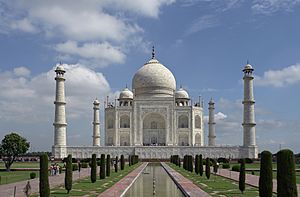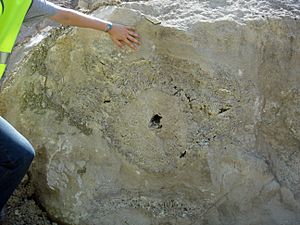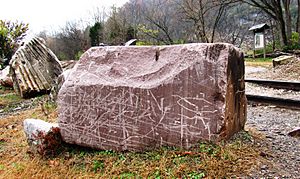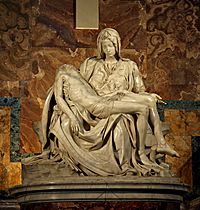Marble facts for kids

- For the toy, see marbles
Marble is a type of rock that forms when limestone changes under great heat and pressure. This process is called metamorphism, which means "change in form." Most marble is made of a mineral called calcite. Calcite is a crystalline form of calcium carbonate, which is also found in seashells.
People have used marble for thousands of years. It's famous for making sculptures and as a building material. You can also find it in many other places, like floors and countertops.
The word "marble" can also mean other shiny stones that can be polished. Sometimes, it even refers to the small, round balls used in children's games. "Faux marble" is a painting style that makes walls look like real marble. Also, marble dust can be mixed with other materials to create "cultured marble."
Ancient Greek and Roman sculptors and architects loved using marble. Many famous places are named after this stone. These include Marble Arch in London, the Sea of Marmara, and India's Marble Rocks. The famous Elgin Marbles are marble sculptures from the Parthenon in Greece. They are now in the British Museum in Britain.
Contents
What is Construction Marble?
In the construction world, the term "marble" is used a bit more broadly. It often refers to any strong, crystalline rock that looks like marble and can be used for building. This can include some rocks that aren't technically true marble.
Different Types of Building Marble
There are many types of marble and marble-like stones used in construction. Here are a few examples:
Purbeck Marble
Purbeck marble is a special kind of limestone found in Dorset, England. It has many fossils inside it, which makes it unique. People have quarried this stone since Roman times to use as a decorative building material. Today, this quarrying is no longer active.
Tennessee Marble
Tennessee marble is actually a type of dolostone, not true marble. Geologists call it the Holston Formation. It comes in colors from gray to pink to maroon. Because it has a crystalline structure, it looks a lot like real marble, especially when it's polished.
Carrara Marble
Carrara marble is a genuine marble. It is famous for its pure white or blue-grey color and high quality. This marble is very popular for sculptures and building decorations. It is quarried near the city of Carrara in Tuscany, Italy.
One of the most famous sculptures made from Carrara marble is The Pietà. This masterpiece by Michelangelo is in St. Peter's Basilica in Vatican City. It's the only artwork Michelangelo ever signed.
How Marble is Used in Industry
Colorless marble is a very pure source of calcium carbonate. This makes it useful in many different industries.
Finely ground marble powder is an ingredient in things like paint, toothpaste, and plastics. Calcium carbonate can also be heated to a very high temperature. This process creates calcium oxide, also known as "quicklime." Quicklime is a main ingredient in most cements.
Related pages
Images for kids
-
The Taj Mahal is entirely covered in marble.
-
Carlo Franzoni's life-size marble chariot clock, the Car of History, showing Clio, the Greek muse of history (National Statuary Hall, U.S. Capitol Building).
-
A marble wall in Ruskeala, Republic of Karelia, Russia.
-
Folded and weathered marble at General Carrera Lake, Chile.
-
The Library of Celsus in Ephesus, Turkey. Turkey is the world's largest marble exporter.
-
Marble products from Romblon, Philippines.
-
The Statue of Abraham Lincoln (Lincoln Memorial), sculpted by Daniel Chester French from Georgia Marble in 1920.
-
Jadwiga of Poland's sarcophagus by Antoni Madeyski, in Wawel Cathedral, Cracow.
See also
 In Spanish: Mármol para niños
In Spanish: Mármol para niños













